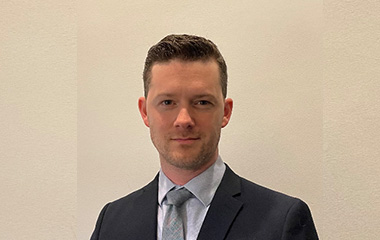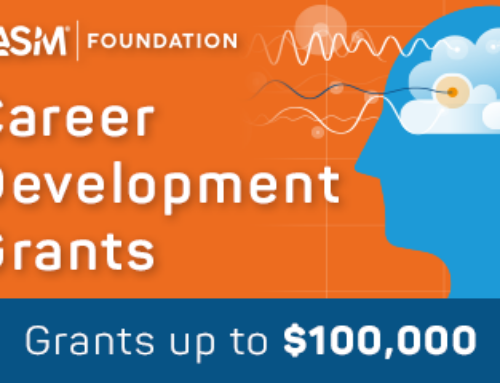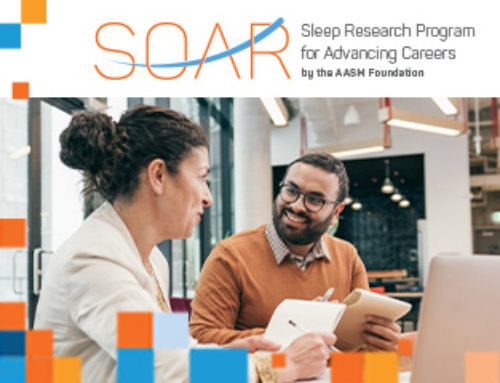The AASM Foundation is dedicated to developing the careers of sleep and circadian investigators by increasing support for sleep and circadian investigators at various stages of their careers. In 2022, the AASM Foundation awarded more than half a million dollars to support projects which will study a range of sleep disorders and bolster the careers of sleep researchers.
American Board of Sleep Medicine Junior Faculty Grant
 Kevin Motz, MD
Kevin Motz, MD
John Hopkins University School of Medicine
Assessing Stimulated Upper Airway Mechanics to Predict Outcomes in Hypoglossal Nerve Stimulation therapy for OSA
About the Project
Obstructive sleep apnea (OSA) is a condition described as the repeated collapse of the upper airway resulting in strained or completely cut-off airflow during sleep. Continuous positive airway pressure (CPAP) is the most common therapy for OSA, but still leaves many still struggling with OSA. Because of this treatment efficacy gap, hypoglossal nerve stimulation (HGNS) is a new, evolving technology designed to help those that are intolerant to CPAP. This project looks to make connections between the effects of HGNS and the degree of upper airway collapsibility in order to better understand the capabilities of HGNS therapy.
Impacts
The goals of this project are to form a better understanding of the influence of upper airway collapsibility on the success of HGNS therapy. This understanding will help to improve precision-based care. Additionally, the completion of this project will allow Motz to begin a new career as an independent clinician-scientist focused on OSA.
 Christopher Schmickl, MD, PhD
Christopher Schmickl, MD, PhD
University of California, San Diego
Endotype-Targeted Therapy to Rescue OSA Patients Struggling with CPAP Adherence (TOP-CPAP): A Pilot Trial
About the Project
Obstructive sleep apnea (OSA) is a condition described as the repeated collapse of the upper airway resulting in strained or completely cut-off airflow during sleep. Continuous positive airway pressure (CPAP) is the most common therapy for OSA, but still leaves many still struggling with OSA. Because of this treatment efficacy gap, hypoglossal nerve stimulation (HGNS) is a new, evolving technology designed to help those that are intolerant to CPAP. This project looks to make connections between the effects of HGNS and the degree of upper airway collapsibility in order to better understand the capabilities of HGNS therapy.
Impacts
Though CPAP therapy is the most common and efficacious method of treating OSA, some patients have low adherence to CPAP. Because of this, there is a need for clinically applicable interventions to increase adherence to CPAP. This project tests the hypothesis that rescue-therapy with eszopiclone will improve CPAP adherence in order to provide better precision-based care to undertreated OSA patients.
IMPACTS The goal of the project is to better help and treat those suffering from OSA. Should the project be a success, eszopiclone will lead to a greater adherence to CPAP, helping those who formerly did not respond very well to it. Also, Schmickl hopes to launch a career as an independent physician with the mission of promoting healthier lives through better sleep.
Bridge to Success Grant for Early Career Investigators
 Vaishnavi Kundel, MD
Vaishnavi Kundel, MD
Icahn School of Medicine at Mount Sinai
Use of Novel Multi-Modality Imaging to Investigate the Relationship Between Sleep Duration, Vascular Inflammation, and Visceral Adiposity
About the Project
Short sleep is highly prevalent in the US and has been connected to cardiovascular disease (CVD), atherosclerosis, and visceral obesity. Considering the many health detriments associated with short sleep, this project attempts to discover a correlation between short sleep and vascular and visceral adipose tissue (VAT) inflammation. VAT inflammation is a key predictor of CVD. With the goal of better understanding short sleep and VAT inflammation, this project can help underscore sleep duration as a modifiable risk factor for CVD.
Impacts
Kundel seeks to advance her academic career by engaging it patient-oriented research and further explore the connection between sleep and cardiometabolic disease. The findings from this project will help people to better understand the health risks of short sleep, possibly helping to reduce these risks.
Bridge to Success Grant for Mid-Career/Senior Investigators
 Jonathan Jun, MD
Jonathan Jun, MD
John Hopkins University
Metabolic Effects of Melatonin-based Meal Timing
About the Project
The timing of meals may affect the way that food is metabolized. According to a previous lab report, eating dinner late correlated with increased glucose levels and decreased dietary fat oxidation. Additionally, those with earlier sleep onset generally had lower fat oxidation rates and glucose tolerance. This project aims to discover more about the metabolic process and overall fat oxidation through the measurement of dim-light melatonin onset (DLMO) in obese/prediabetic subjects.
Impacts
This project looks to discover a correlation between timing of meals, DLMO, glucose tolerance, and fat oxidation. The results may lead to more comprehensive health information, helping those who struggle with sleep and metabolic health.
Focused Projects Grant for Junior Investigators
 Rebecca Cox, PhD
Rebecca Cox, PhD
University of Colorado
A Circadian Medicine Light-based Intervention for Obsessive-Compulsive Disorder
About the Project
Increasing data demonstrates delayed circadian rhythms on individuals with obsessive-compulsive disorder (OCD). This project investigates the possibility of a novel treatment method for OCD: morning light therapy and test its efficacy. The intervention of children and adults with ODC will include regular wake timing, morning light therapy, and reduced evening light exposure.
Impacts
Historically, research for OCD treatments has been centered around enhancing existing treatments, not developing new ones. The findings from this uncharted project will help to determine new treatments for those struggling with OCD. Through this project Cox will receive training in melatonin phase and light exposure assessments.
 Melanie Stearns, PhD
Melanie Stearns, PhD
University of Missouri
Transactional Relationship between Child Behavior and Sleep
About the Project
Half of the children in the US diagnosed with Oppositional Defiant Disorder (ODD) have difficulty sleeping which impairs psychosocial functioning. Sleep problems have also been associated with hyperarousal, but studies on the connection of arousal and children with ODD are overall inconclusive. To understand this connection more, this project aims to discover the correlation of fluctuations in child behavior and child sleeping habits.
Impacts
Defining the associations between child behavior and sleep will better inform and help find solutions to child sleep problems. ODD is linked to increased parental stress and poor family cohesion, which may have a lot to do with sleeping patterns. The impact of this project will be the enablement of the optimization of intervention programs that help these struggling families.
Focused Projects Grant for Junior Investigators: National Sleep Research Resource
 Joon Chung, PhD
Joon Chung, PhD
Brigham and Women’s Hospital, Harvard Medical School
Leveraging The National Sleep Research Resource to Enhance Understanding of Sleep Health Across Populations
About the Project
This project aims to use a holistic understanding of a population in order to best use objective data for sleep health. Specifically, the project looks at age and sex variation, actigraphy data, and sleep metrics to explore topics of short sleep and mortality as well as behaviorally targetable sleep characteristics. In addition to researching two its two aims, this project will deposit its newly harmonized metrics in the National Sleep Research Resource.
Impacts
This project impacts Chung’s career development by giving him the opportunity to create a distinct research niche and utilizing multi-cohort analyses in sleep epidemiology. Also, this project opens the doors to harmonize cohorts and work more collaboratively.
 Yan Ma, MBBS, MD, MPH
Yan Ma, MBBS, MD, MPH
Brigham and Women’s Hospital
Physiological Dynamics of the Sleep Onset Process: Conventional and Novel Analyses using SHHS Data
About the Project
There is a possibility that the psychological dynamics that occur during the wakefulness period of sleep may affect sleep onset and even the quality of sleep. This project looks to test the hypotheses that inherent brain physiological signals are determinants of insomnia, physiological biomarkers obtained during the day and associated with sleep quality in the night, and that a combination of linear and nonlinear analysis will produce a better understanding of the connections between wakefulness, sleep, and insomnia.
Impacts
This project may provide information on pre-sleep physiology, hyper-arousal, and sleep-onset which can be used for future research. Additionally, Ma will be able to promote her career development in clinical research.
Physician Scientist Training Grant
 Jacqueline Geer, MD
Jacqueline Geer, MD
Yale University
Evaluating Neurological Recovery in Intracerebral Hemorrhage and Sleep Apnea (ENRICH-SA) Study
About the Project
Intracerebral hemorrhages (ICH) account for about 20 percent of strokes. At present time, there are limited treatment strategies to combat these hemorrhages. Leading from the fact that OSA is a proven factor of ischemic strokes, it was determined that about 70 percent of ICH patients have high risk of OSA. This project observes ICH patients who will be assessed for OSA, looking to determine a correlation between the two.
Impacts
ICH is an extremely dangerous, and at times fatal. This project aims to improve outcomes of ICH through the determination of OSA as a risk factor, which could in turn improve mortality rates.
 Thomas Tolbert, MD
Thomas Tolbert, MD
Department of Medicine at the Icahn School of Medicine
The Effect of Left Ventricular Diastolic Dysfunction on Sleep-Disordered Breathing Pathophysiology
About the Project
Statistically, patients with heart failure also have a high tendency of sleep-disordered breathing (SDB) including OSA and central sleep apnea (CSA). Left ventricular diastolic function (LVDD) is also associates with heightened numbers of OSA and CSA. However, the effects of LVDD on SDB remain unexplored. This project utilizes a cross-sectional approach to determine the relationship between LVDD and SDB.
Impacts
Through this project, Tolbert will learn more about the discipline of conducting patient-oriented studies. The long-term goal is to contribute valuable information about a bidirectional relationship between SDB and LVDD.





